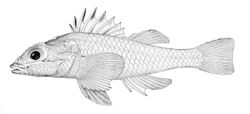Biology:Plectrogenium
| Plectrogenium | |
|---|---|

| |
| P. nanum | |
| Scientific classification | |
| Domain: | Eukaryota |
| Kingdom: | Animalia |
| Phylum: | Chordata |
| Class: | Actinopterygii |
| Order: | Scorpaeniformes |
| Family: | Scorpaenidae |
| Subfamily: | Plectrogeninae Fowler, 1938 |
| Genus: | Plectrogenium C. H. Gilbert, 1905 |
| Type species | |
| Plectrogenium nanum Gilbert, 1905
| |
Plectrogenium, is a genus of marine ray-finned fishes, the stinger flatheads, the only genus classified within the subfamily Plectrogeninae, which in turn is classified within the family Scorpaenidae. This genus is found in the Indian and Pacific Oceans.
Taxonomy
Plectrogenium was originally named as a monotypic genus in 1905 by the American ichthyologist Charles Henry Gilbert when he described what was then considered to be its only species,[1] Plectrogenium nanum, from Hawaii.[2] Plectrogenium is the only genus in the monotypic subfamily Plectrogeninae which is classified within the family Scorpaenidae in the order Scorpaeniformes by some authorities.[3] Other authorities treat this taxon as part of a separate family Plectrogenidae, alongside the genus Bembradium, and place this family in the perciform suborder Platycephaloidei.[4] The genus name, Plectrogenium, is a compound of plectro, which means “spur”, and genys, which means “cheek”or “chin”, an allusion to the lines of robust spines along the sides of the head.[5]
Species
The currently recognized species in this genus are:[1]
- Plectrogenium barsukovi Mandritsa, 1992
- Plectrogenium capricornis Matsunuma, Uesaka, Yamakawa & Endo, 2021
- Plectrogenium kamoharai Uesaka, Yamakawa, Matsunuma & Endo, 2021
- Plectrogenium kanayamai Uesaka, Yamakawa, Matsunuma & Endo, 2021
- Plectrogenium longipinnis Matsunuma, Uesaka, Yamakawa & Endo, 2021
- Plectrogenium megalops Matsunuma, Uesaka, Yamakawa & Endo, 2021
- Plectrogenium nanum C. H. Gilbert, 1905
- Plectrogenium occidentalise Matsunuma, Uesaka, Yamakawa & Endo, 2021
- Plectrogenium rubricauda Matsunuma, Uesaka, Yamakawa & Endo, 2021
- Plectrogenium serratum Matsunuma, Uesaka, Yamakawa & Endo, 2021
Characteristics
Plectrogenium is characterised by having a laterally compressed body with a number of spines and ridges on the head. There are venom glands on the spines in the dorsal, anal and pelvic fins.[6] The dorsal fin typically has 12 spines and 71/2 soft rays, the dorsal fin is split into 2 fins with 2 spines in the anterior part of the second dorsal fin. There are between 22 and 25 rays in the pectoral fins and they have 30-35 vertical rows of ctenoid scales on the body. There are flattened spines on the suborbital ridge which resembles that of the Platycephalidae. The mouth is positioned ventrally.[7] They are small fishes with standard lengths of less than 10 cm (3.9 in)[8]
Distribution and habitat
Plectrogenium is found in the Indian and Pacific Oceans from Madagascar to Hawaii.[9] They are bathydemersal fishes which are found at depths greater than 250 m (820 ft).[6]
References
- ↑ 1.0 1.1 Eschmeyer, William N.; Fricke, Ron; van der Laan, Richard, eds. "Genera in the family Plectrogeniidae". California Academy of Sciences. http://researcharchive.calacademy.org/research/ichthyology/catalog/fishcatget.asp?tbl=genus&family=Plectrogeniidae.
- ↑ Eschmeyer, William N.; Fricke, Ron; van der Laan, Richard, eds. "Species in the genus Plectrogenium". California Academy of Sciences. http://researcharchive.calacademy.org/research/ichthyology/catalog/fishcatget.asp?tbl=species&genus=Plectrogenium.
- ↑ J. S. Nelson; T. C. Grande; M. V. H. Wilson (2016). Fishes of the World (5th ed.). Wiley. pp. 468–475. ISBN 978-1-118-34233-6. https://sites.google.com/site/fotw5th/.
- ↑ Ricardo Betancur-R; Edward O. Wiley; Gloria Arratia et al. (2017). "Phylogenetic classification of bony fishes". BMC Evolutionary Biology 17 (162): 162. doi:10.1186/s12862-017-0958-3. PMID 28683774.
- ↑ Christopher Scharpf; Kenneth J. Lazara, eds (7 December 2021). "Order PERCIFORMES: Suborder PLATYCEPHALOIDEI: Families BEMBRIDAE, PARABEMBRIDAE, PLATYCEPHALIDAE, HOPLICHTHYIDAE and PLECTROGENIIDAE". The ETYFish Project Fish Name Etymology Database. Christopher Scharpf and Kenneth J. Lazara. https://etyfish.org/perciformes11/.
- ↑ 6.0 6.1 Froese, Rainer; Pauly, Daniel, eds (February 2022). "Family Plectrogeniidae - Stinger flatheads". https://www.fishbase.se/Summary/FamilySummary.php?ID=579.
- ↑ William N. Eschmeyer; John E. Randall (1975). "The Scorpaenid Fishes of the Hawaiian Islands Including New Species and New Records (Pisces:Scorpaenidae)". Proceedings of the California Academy of Sciences. Series 4 40 (11): 265–334. https://www.biodiversitylibrary.org/page/15774513#page/275/mode/1up.
- ↑ Froese, Rainer and Pauly, Daniel, eds. (2022). Species of Plectrogenium in FishBase. February 2022 version.
- ↑ Matsunuma, M.; Uesaka, K.; Yamakawa, T.; Hiromitsu Endo (2022). "Review of the Indo-Pacific scorpaenoid genus Plectrogenium Gilbert 1905 (Plectrogeniidae) with descriptions of eight new species". Ichthyological Research 69 (3): 299–351. doi:10.1007/s10228-021-00844-z.
Wikidata ☰ Q2325680 entry
 |

